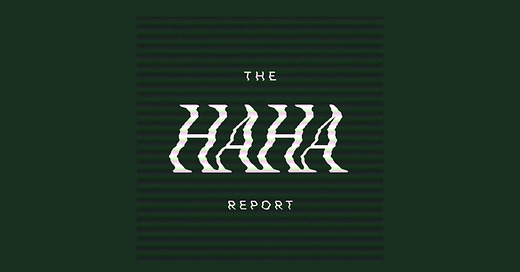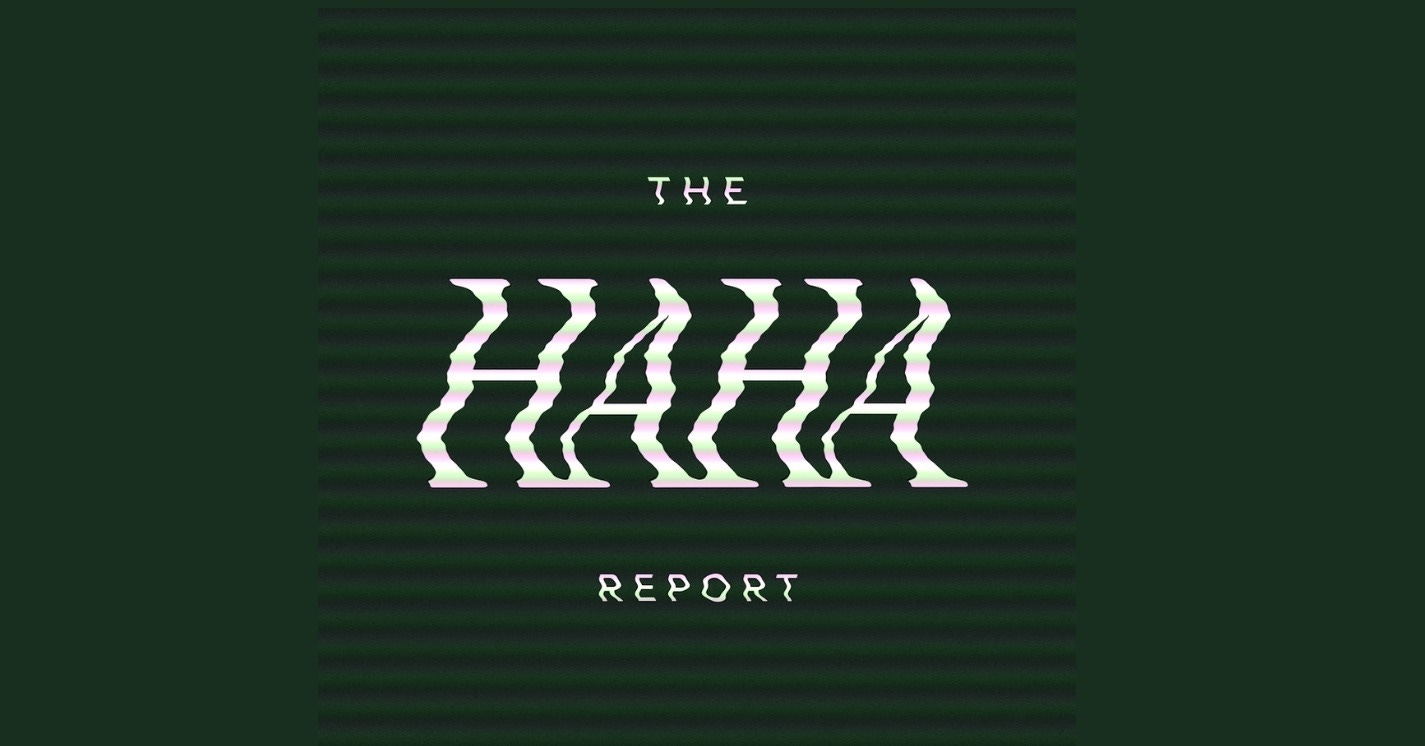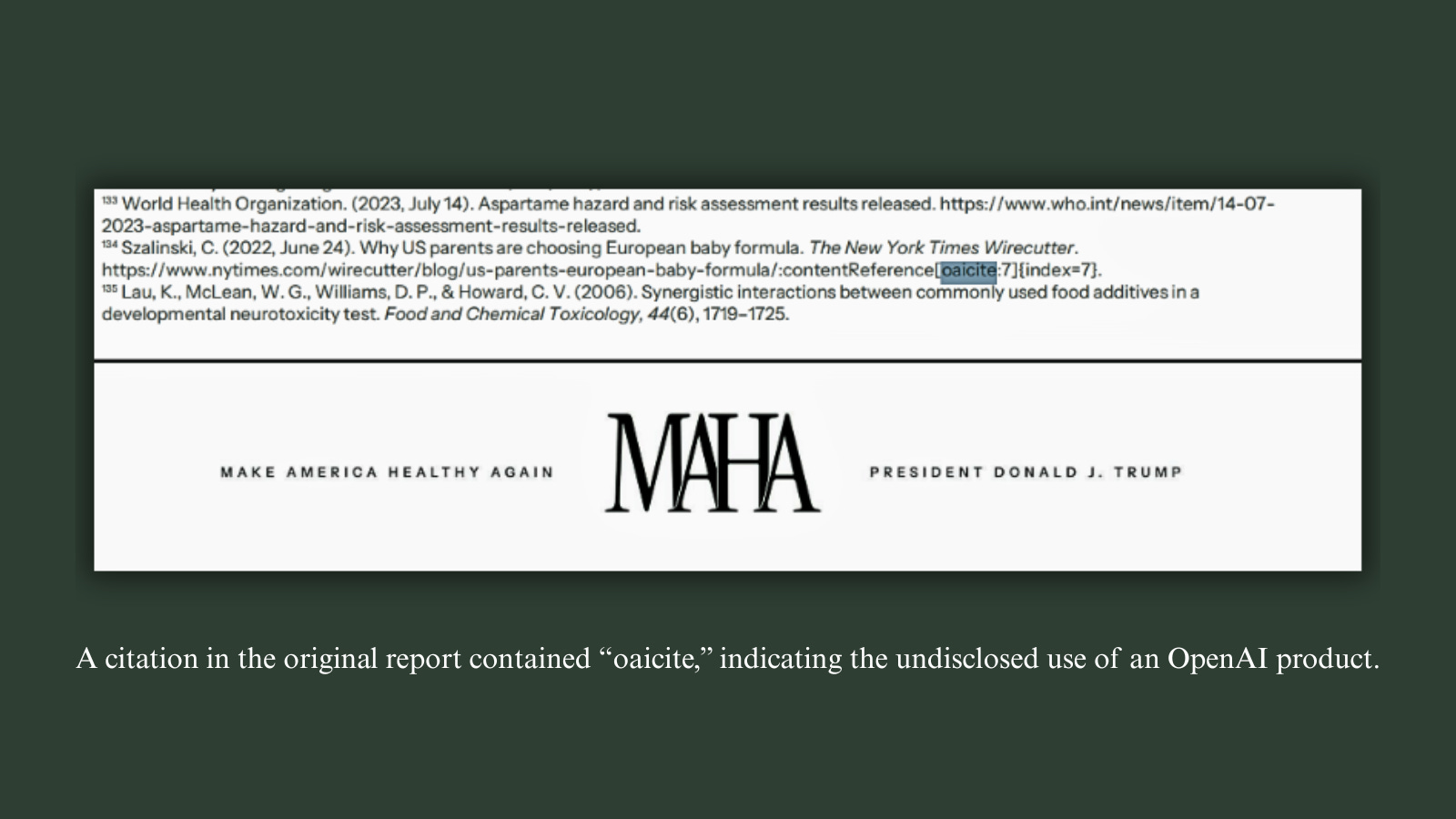MAHA Report Appears to Plagiarize a 2023 Document Published During RFK Jr.’s Tenure at CHD
The report maintains a veneer of inquiry, but its structure and many of its claims closely mirror those of a document produced under RFK Jr.'s leadership at another organization.
The full report in PDF format will be available to paid subscribers as soon as it is ready. There were so many pieces to this picture that it seemed best to publish the most pressing findings now and to take more time with the analytical portions. Please see the report’s AI disclosure.1 AI tools were used for proofreading and quality checks.
Hyperlinks are used throughout when there is source material to access. Footnotes are used when there is lengthy but relevant context that may be of interest but is not appropriate for inclusion in the main text.
Plagiarism, Undisclosed AI, and Disappearing Science
SECTIONS
This is not normal.
The Make Our Children Healthy Again (MAHA) Assessment positions itself as a neutral, evidence-based government analysis. Yet it replicates nearly all core themes from an activist group whose former leader now oversees the agency issuing the report. No disclosure was provided. No attribution was given. If this were a serious publication, it could well end the career of an ordinary scientist.
To publish a document of this magnitude—knowing it would reflect poorly on the administration that entrusted Health and Human Services Secretary Robert F. Kennedy Jr. with this extraordinary opportunity—filled with recycled arguments, plagiarized content, nonexistent sources, and without disclosure about the use of AI, shows a disregard for so much more than science. It disrespects the office of the President who commissioned this work; it embarrasses the United States on the global stage and casts doubt on the U.S. as a serious actor in science. It disrespects the broader research community, which has built the credibility, clarity, and consensus that our lives depend upon.
Most of all, this act shows contempt for the very community that Secretary Robert F. Kennedy Jr. (RFK Jr.) represents. It is a community filled with people who feel and, in many cases, have been unheard by conventional medicine. No agreement is needed to understand the desperation they feel. It is hard to fathom a more callous betrayal of their hope than having the ability to make a difference in their lives and wasting that chance.
Scientific integrity is not a procedural formality. It is not a costume. It is the very means by which we demonstrate that we are worthy of public trust. Every researcher, reviewer, and policymaker who adheres to expected citation practices does so out of respect for the people whose work came before, the public who relies on our work now, those who will rely upon it in the future, and the truth that we are duty-bound to pursue.
To bypass those standards, particularly when the subject is children's health, suggests not just carelessness, but an absence of any level of commitment to sound science or good governance.
Rather than building upon the legacy of those who eliminated polio and malaria in the U.S., eradicated smallpox, and created a world where mothers and fathers can reasonably hope to raise all of their children to adulthood, the MAHA Assessment overlooks how that happened entirely.
Cloaking activism in the language of science, it delivers neither and compromises both.
At a time when the nation requires principled leadership and credible public health guidance, this report falls short in both respects. Its shortcomings are not limited to technical failings; they represent a profound ethical and moral abdication. It would be difficult to articulate a stronger condemnation.
Overview.
The Make Our Children Healthy Again (MAHA) Assessment, a May 2025 publication from the Presidential MAHA Commission, presents an alarming view of child health in the United States. Despite its government imprimatur, the MAHA Assessment is not an original scientific product. It closely mirrors earlier publications from Children’s Health Defense (CHD).
The 2023 report, Chronic Health Conditions Among Children, from CHD and the 2024 Vaccine Curriculum, together form a template with which you could write much of the 2025 MAHA Assessment. The tone and format have been changed to one that sounds more like legitimate policy.
What it presents as new is a reformatting and updating of older, activist content. All three of the documents arrive at the same message:
American children face a concealed health crisis; the cause is modern industrial and medical practices; and institutions have either failed to confront it or deliberately contributed to it. Bold action is needed to stop it.
Everything in these reports leads to that conclusion.
The close resemblance to the CHD reports suggests that it not only contained undisclosed AI-generated content but also offered limited new information, meaning it required little to no effort.
A compendium of overlapping and similar text can be found in the Text Comparisons section. One example of a misleading claim replicated across the reports is the claim about the state of child health.
CHD (2023): “American children have never been so sick” (p. 1).
CHD (2024): "Why are our kids so sick?" (p. 1)
MAHA (2025): "Today’s children are the sickest generation in American history in terms of chronic disease..." (p. 7)
Comment: Two hundred years ago, around half of all children born in the United States died before their fifth birthday. By the year 1900, one out of every five children still died, regardless of class or wealth. The U.S. lagged behind other countries despite ample food and exercise. The urban infant mortality rate was 57.1 deaths per 1,000 live births in 1933. As of 2022, the U.S. national child mortality rate is 5.4, and in the top states, it drops below 3.5. This reflects a nearly 90% decline from the 1933 rate. This transformation is due to vaccines, better neonatal care, sanitation, antibiotics, and public health initiatives. This shift represents one of the greatest improvements in child survival ever recorded.
In another example, the MAHA Assessment repeats a false claim from CHD:
CHD (2024): "Industry-funded vaccine studies are inherently flawed and poorly designed... Almost none use inert placebo controls..." (p. 1).
MAHA (2025): "Many vaccines on the CDC’s childhood schedule involved small participant groups, had no inert placebo-controlled trials..." (p. 63)
Comment: The CHD and MAHA statements conflate ethical trial design constraints and standard phase-based methodologies with flawed science. The use of active comparators in many cases is due to ethical requirements, not poor design. The presence of industry funding does not invalidate a trial’s rigor, particularly when it meets all regulatory, statistical, and methodological standards. Claims to the contrary misrepresent scientific standards and risk misleading the public. Industry can have a corrosive effect on science, but assuming it in all cases is unwarranted.
The MAHA Assessment adopts the language of science to repackage material that appears to have been produced during Robert F. Kennedy Jr.’s tenure at CHD. The report makes no mention of this sourcing.
Review of Report Priorities.
The opening of the Make Our Children Healthy Again (MAHA) Assessment sets the tone for the rest of the document. It immediately departs from what readers might expect in a government health report. Instead of beginning with epidemiological trends or health benchmarks, the first paragraph opens with a sweeping indictment of U.S. institutions.
The authors assert that public health has been subordinated to corporate interests, that the medical field is complacent, and that children are being over-medicalized and chronically stressed. The evidence for this is insufficient and largely unaddressed. Specific examples with an exploration of vulnerabilities are absent, too.
The report concludes by calling for a "Great American Comeback" that ties AI, agriculture, and energy dominance to child health outcomes —a connection that is unusual for a report on children’s health.
This style of introduction—ideologically driven, emotionally charged, and loosely connected to evidence—is more suitable for activism or politics than for scientific or public health documents.
The report raises valid concerns, such as the harms associated with ultra-processed foods, excessive screen time, and overprescription of medications. But these are not assessed using the vast resources available at HHS.
Instead, the priorities are embedded in a story that largely bypasses standard practices: terms go undefined, claims are unsubstantiated, and causal pathways are either implied or conflated.
We are left to wonder what this report means when it mentions “chronic illness,” and why the report on children’s health would list, as one of its guiding principles, “American farmers are put at the center of how we think about health.”
In a report that is so broadly focused that it discusses children’s health in relation to agriculture and energy dominance, the conspicuous absence of topics directly related to child health, such as the drivers of child mortality, is jarring. The single greatest killer of children in the United States today is not mentioned at all.
Scientific Standards.
The MAHA Assessment fails multiple criteria for scientific integrity. Its overreliance on selective evidence, failure to contextualize claims, and reliance on emotionally charged or conspiratorial framing limit its ability to provide insight. Additionally, the lack of appropriate conflict of interest disclosures and the apparent absence of a clear methodology render the report inert, much like the “true placebo” it discusses extensively.
Clarity of Scope: The report’s scope is so expansive that it compromises analytical rigor. The MAHA Assessment aims to address nearly every conceivable factor that affects childhood health, including diet, environmental toxins, vaccines, screen time, and other relevant factors. While this reflects an understanding that chronic illness has multifactorial origins, the breadth comes at the expense of depth, coherence, and actionable guidance.
A scientifically rigorous report would clearly define its terms, set inclusion criteria, apply consistent standards of evidence, and make its source data available for external scrutiny. Instead, MAHA presents selective interpretations of established health risks, disregards decades of collaborative scientific progress, and strays from substantive analysis into personal attacks, undermining both its credibility and utility.
Use of Evidence: The MAHA Assessment includes hundreds of citations, including peer-reviewed research and government data. Some references were unverifiable and likely AI-generated, including links that do not resolve to actual studies.
The document selectively cites findings that support a crisis narrative while omitting contradictory research. For example, the report highlights uncertainties in the vaccine safety literature while overlooking the consensus findings of numerous large-scale studies.
These are not dismissed or downplayed; they are completely omitted from consideration. It relies heavily on innuendo and implication, without making any assertions.
Evidentiary Rigor: The report uses qualifying language, avoiding explicitly false claims. For example, it notes that vaccine schedules "warrant further inquiry” and states that “vaccines can have a wide range of adverse effects.” These caveats do not offset the overwhelming imbalance of emphasis. Speculative concerns feature prominently alongside assertions that they should be funded and explored.
This strategy—raising questions that cast doubt on what is known—is more reminiscent of Russia Today circa 2015 than a scientific investigation. It may have a place in activism and state-controlled media, but it has no place in a document intended to serve the public.
There is little information in the report itself. Examples of high-quality studies that the MAHA Assessment could have cited, given its priorities:
Fast Food Intake Among Children and Adolescents in the United States, 2015–2018
Fruit and Vegetable Consumption Among Children and Adolescents, 2015–2018
The Use of Crisis Services Following the Mass School Shooting in Uvalde
Neurotoxic Effects of Mixtures of PFAS at Environmental and Human Blood Concentrations
Combined Exposure to Folate and Lead during Pregnancy and Autistic-Like Behaviors
It’s unclear whether any resources or expertise at HHS were used in drafting the report.
Transparency of Sources: The MAHA Assessment frequently relies on outdated, unreliable, or misinterpreted sources. No attempt to adequately weigh the evidence appears in the text. If sources cited in the report have commercial or ideological interests, such as authors selling detox supplements, affiliations with activist groups, or involvement in litigation, and these ties are not disclosed, the report fails to meet standard disclosure norms.
While Secretary Kennedy has transferred the rights to the MAHA trademark for now, a disclosure regarding prior associations, funding, or potential benefit would be appropriate.
Transparency about financial and ideological incentives is standard in both science and policy reporting.
Presentation of Data: The MAHA Assessment engages in rhetorical overreach rather than scientific analysis. It cites increasing autism rates without discussing changes in diagnostic criteria, increased awareness, or population screening. Omission of this context is either uninformed or deliberately misleading.
Claims such as "children today are the sickest generation in American history" are illustrative. “Sickest” is not a recognized medical term, and the report does not define it. Such a claim would usually require definitions and baseline comparisons, even if it were true. Here, it’s blatantly false. As mentioned previously, two hundred years ago, around half of all children born in the United States died before their fifth birthday. Deaths have declined by 99%.
Conspiratorial Framing: The report insinuates, without substantiating, that public health institutions have deliberately suppressed data or ignored critical evidence. It references the National Vaccine Injury Compensation Program and manufacturer liability protections as signs of corruption but fails to provide legal or historical context.
It also asserts that “physicians who question or deviate” from CDC guidelines face consequences, yet offers no evidence of systematic suppression. Disciplinary actions, if they exist, are not analyzed for merit or frequency. Instead, the report relies on anecdote.
Most concerning, the report vilifies entire professional communities—portraying physicians, scientists, and public health officials as malicious or complicit. This framing is not only inappropriate in a serious policy document, but it also reflects a fundamental disregard for evidence-based discourse. In any setting that demands objectivity, trust, and expertise, it signals a lack of fitness for public leadership in health policy.
What’s Missing?
The MAHA report omits several glaring public health issues that should be central in any serious assessment of child health in the United States. Despite its length and data-heavy appearance, the MAHA Report frames child health narrowly through an anti-regulatory, anti-pharmaceutical, and pro-agriculture lens. It omits the leading cause of child mortality, downplays successful public health interventions, and disregards social determinants that play a significant role in child health.
There is no examination of well-documented disparities in risk and access to care. The report fails to mention key environmental threats facing children today, such as wildfires, drought, flooding, or heat, despite being dominant environmental health threats for U.S. children. Heat during pregnancy, too, poses a threat. Maternal hyperthermia in early pregnancy is a teratogen, something capable of causing neural tube defects like spina bifida.
There is no serious exploration of individual differences in susceptibility—no integration of genetic, epigenetic, or comorbidity data. Technology was limited to a vague plan to implement “AI,” although for what remains unclear. This is at the same time that the Commission fails to address serious infrastructure or capacity that would improve health, such as computational modeling, omics-scale data, or advanced analytics.
Gun Violence – The Leading Cause of Death in Children
Firearms are the number one killer of children and teens in the United States, surpassing car accidents and disease. Any comprehensive analysis of child health must address the leading cause of child death in the United States.
Determinants of Health
There is no meaningful engagement with the role of poverty, housing insecurity, environmental exposures, or systemic inequality. These are well-documented, high-impact factors on child development and long-term health outcomes. There is no systematic accounting for the full scope of environmental exposures across a child's lifespan, despite toxic exposures being one of the few topics addressed in the report.
Mental Health and Suicide
The report does not address the crisis in pediatric mental health and self-harm among adolescents. This omission ignores one of the most pressing challenges facing today’s youth. While it does address prescriptions for depression, it mainly characterizes them as overprescribed, offering no meaningful roadmap to address this.
Nutrition Insecurity
While the MAHA Assessment discusses chronic disease, it fails to connect food insecurity and poor nutrition access to rising obesity and diabetes rates in children, especially in low-income communities. While a gentleman’s agreement with companies to remove food dye is a start, there are zero food dye-related deaths among children in the U.S. each year.
Lack of Evidence-Based Interventions
The report gives no attention to the success of existing public health strategies, such as early childhood interventions, vaccine programs, lead abatement, or maternal health support. These programs have transformed child survival in the United States over the last century.
These absences appear to reflect a predetermined endpoint similar to the one reached in earlier reports. Whatever the conclusions, it is difficult to take seriously a report on child health that makes no mention of the greatest threats facing children in the United States today.
Keep reading with a 7-day free trial
Subscribe to InfoEpi Lab to keep reading this post and get 7 days of free access to the full post archives.





